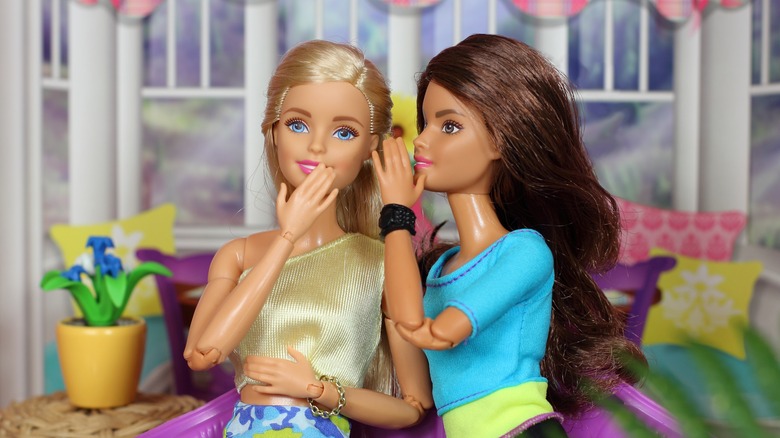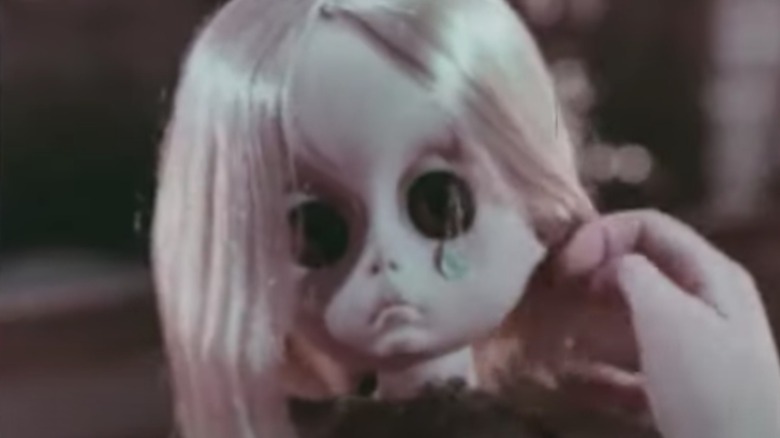Hasbro's Short-Lived Answer To Barbie Was The Stuff Of Nightmares
In March 1959, the Barbie doll was first introduced to the public at a toy fair in New York. Ruth Handler, the co-founder of Mattel, Inc., was inspired to create it after observing her daughter playing with paper dolls of adult women. Barbie became the first mass-produced play doll that had the features of a woman, and it was a big hit. Decades later, Barbie is still loved by children everywhere, and Time named it one of the most influential toys of all time.
According to History, about 300,000 Barbie dolls — at $3.00 each — were sold in its first year of release, and the sales kept increasing as the years passed. Eventually, the toy line expanded with the introduction of Barbie's boyfriend, Ken, and friends and family, such as Hadley and Skipper. Barbie diversified through the years, and today, over 100 Barbie dolls are sold every minute all over the world (via Barbie Media).
While Mattel, Inc. was enjoying great success with Barbie dolls because little girls liked to use them for role play and to act out their ideas of what it may be like to be beautiful, grown women, Hasbro came up with an alternative idea. The toy company decided to market the antithesis of the glamorous Barbie. In 1965 they introduced "Little Miss No Name" (per Toy Tales).
Little Miss No Name was basically an abandoned child
Unlike Barbie, who circa 1964 and 1965 had more than 50 outfits to choose from, along with accessories (per DollReference), according to a Hasbro commercial, "Little Miss No Name is sad because she doesn't have a pretty dress. She doesn't have any shoes. She doesn't even have a name" (via YouTube). Little Miss No Name came in a box that made her look like she was standing barefoot in a snowstorm, wearing only a brown dress made of burlap, complete with a red patch where her sad little dress had been mended.
The doll was marketed as a way for children to love and care for her, ideally to pull her up from her neglected state. The commercial said, "Take your comb and make her hair look pretty." It claimed, "she's the doll that needs more loving care than any doll you've ever had," the commercial goes on to say that she needed a home and added, "Look, she has a tear on her cheek" — a plastic teardrop that was removable — so at least you could stop her from crying. Plus, that's kind of like an accessory, right? Little Miss No Name even had her arm and hand positioned to look as though she was asking for handouts from strangers. But mostly she needed love.
Little Miss No Name was inspired by an artist's work
While her perpetual frown was impossible to get rid of no matter how much love you gave her, the doll's large, vacant eyes are what really stand out. According to Toy Tales, the eyes were inspired by a popular artist from the 1960s, Margaret Keane, whose paintings of children with large and haunting eyes stared out from canvases. In 2014 she told The Guardian, "Those sad children were really my own deep feelings that I couldn't express in any other way. Their eyes were searching. Asking why. Why is there so much sadness? Why do we have to get sick and die? Why do people shoot each other?"
Maybe it's an odd choice to base a toy on such heavy subjects, but, Hasbro also created the G.I. Joe action figure, proving that sometimes real-life scenarios that may be less than desirable translate into fun toys. Actually, The Museum of Failure says that Hasbro was banking on the toy being a success because at that time there was a big push on teaching children to be aware of the misfortunes of others and to treat people with empathy and humanity.
Still, it didn't pan out for Little Miss No Name like it did for Barbie. Per Toy Tales, the doll was taken off the shelf sometime after 1968. However, Little Miss No Name has become a collector item, with asking prices of as much as $700.


